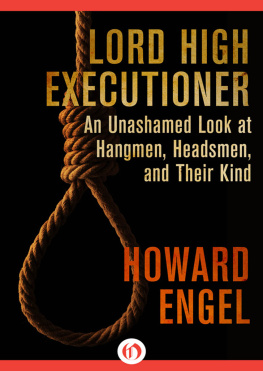Lord High Executioner
An Unashamed Look at Hangmen, Headsmen, and Their Kind
Howard Engel

Acknowledgments
There are a great many people to whom I owe my thanks, people who have helped me with one aspect of the work or another. Among them I would like to thank Kildare Dobbs, David Mason, Scott Tyrer, Dominique Roydon, Bill Gladstone, Gerald Owen, Eric Wright, Diane Francis, John Fraser, Vittorio Frigerio, Prof. Jim Jackson (Trinity College, Dublin), Martin L. Friedland, John M. Beattie, Jerry G. E. Bentley, Jack McLeod, Carolyn Strange, Rona Abramovitch, Hubert de Santana, Dudley Witney, James Carley, David Stafford, Jeanne Canizzo, Meg Taylor, Archie Campbell, Jonathan Freedman, Elizabeth Legge, Asa Zatz, Douglas Fetherling, the Greek Tourist Bureau, the staff of the Conan Doyle Room at the Metro Toronto Public Library, and many other individuals and institutions, whose names, for the moment, are stuck in my failing memory, for their help and encouragement throughout this project.
I would like to thank Frank W. Anderson, the author of Hanging in Canada, for the clippings from the Manitoba Free Press (1899 and 1900) and correspondence with the author in 1972. I owe a similar debt to Prof. Michael Millgate for sending me clippings and chapbooks relating to the execution of Martha Brown at Dorchester in 1856.
My wife, Janet Hamilton, who has encouraged and sustained me, also deserves my thanks, as do my agent, Beverley Slopen, and Anna Porter and Cynthia Good, the publishers, respectively, of my non-fiction and of my fiction, without whom I would be a drag on the remaining social services of this country. Throughout the process of the making of this book they have at various times noted the fact that I have become a glutton for punishment.
Introduction
Behold the Lord High Executioner
A personage of noble rank and title
A dignified and potent officer,
Whose functions are particularly vital!
Defer, defer,
To the Lord High Executioner!
W. S. GILBERT
By and large, executioners have not been personages of noble rank and title. In fact almost every society has counted them among the lowest of the low. True, there have been dynasties of headsmen in France and hangmen in Britain, a kind of parallel aristocracy where the first-born inherited the mantle of office from his father along with a certain dignity that goes with it, but most executioners have come from the same ranks as the criminals they executed and the policemen who enforced the lawsthat is to say, from the lower-middle and working classes. Their functions may have been vitalfew more sobut they were hardly dignified officers of the court. Pariahs, every one of them.
Logically, a case can be made for the social acceptance of the functionary who carries out the sentence of death. He is, after all, merely an extension of the law courts. If no one condemns or stigmatizes a hanging judge, why should the technician who carries out the law be shunned? In The Mikado, Pooh Bah, the portly Lord High Everything Else, explains how it is that the status of executioner stands so high in the town of Titipu:
Our logical Mikado, seeing no moral difference between the dignified judge who condemns a criminal to die, and the industrious mechanic who carries out the sentence, has rolled the two offices into one, and every judge is now his own executioner.
That may have been all very well for the town of Titipu and the topsy-turvy world of Gilbert and Sullivan, but in the world beyond operetta there are claims to be made for the executioner as an important functionary in the legal system. Honest hangmen have for centuries resented being looked down upon by the rest of society. After all, many thought of themselves as the benefactors of society.
The question of whether the public has a right to treat the hangman as an outcast was actually contested in a court of law. It was a judge, not a jury, who had to decide the question. The English Law Journal of 28 July 1926 describes the case of a man who, arriving in Norwich on the eve of an execution, was taken by a bystander for the hangman and thrown into a duck pond by the mob that quickly collected. All the while, the first irate citizen shouted: You are Jack Ketch! The mob echoed: You are Jack Ketch, the hangman! Let me allow Louis Blake Duff to take up the story at this point:
The victim consulted his lawyer and decided to sue the man who had called him the hangman. The defence claimed the allegation could not possibly be defamatory.
The executioner, said the defence lawyer, is a public official, necessary to the security of the State, and it is no more a libel to describe a man as a hangman than to say he is a judge.
The judge listened to this argument and in the very teeth of it awarded damages. So the outrageous prejudice against the hangman has invaded even the bench whose faithful necessary servant he is. To say the least, it is hardly sporting.
Hangmen and headsmen have been in the back of our minds for hundreds of years. They are the bogeymen of our worst nightmares, the shape of our darkest fears. They stalk the subconscious in thick leather boots carrying with them the bloodstained tools of their deadly mystery. They repel and revolt us, and, against all rationality, attract and fascinate us. They have been closest to the line between life and death. The mystery and majesty of the law have been condensed into these appalling shapes. They stand at the entrance to the dungeons of our worst dreams, beckoning with their hands: Come with me. The executioner is at once hated and feared, and yet he may go where no man may go. He is wrapped up in our primitive selves, personifying the atavism that lives deep within all of us. To understand ourselves, it is important to face the irrational, the phobic, the taboos of the society that created this unpleasant stand-in for everyman.
In our reading, the executioner often stands just offstage in the wings. Like the deus ex machina of the drama, the headsman casts a long shadow through fiction. For instance, it is impossible to fully understand Dickens, Thackeray, and Hardy without seeing the mark of the gallows on their work.
At the same time, executioners have added to the lore of language: Derrick, a hangman from the early seventeenth century, who operated upon the legendary gallows at Tyburn, gave his name to a device for hoisting heavy objects. Jack Ketch, towards the end of the century, gave his name to the whole breed of hangmen. His very name became synonymous with executioner. Of him his wife is reported to have said:
Any bungler might put a man to death, but only her husband knew how to make a gentleman die sweetly.
The crusade against capital punishment is a distinguished and long one. Throughout history there have always been a few farsighted people who were ready to lead that crusade. But it was only in the nineteenth century that signs of improvement began to appear. In Britain, the Bloody Codethe ever-growing catalogue of crimes which brought the death sentencewas trimmed of many capital offenses, and the forms of execution were consolidated: in Britain, the gallows; in France, the guillotine. The spirit of reform was in the air, of course, but sometimes it turned up in odd places. Turning the pages of Punch, the satirical magazine published in London, one finds short squibs aimed at the hangmanwho in the traditional Punch and Judy show, you will remember, ends up on his own gallows. This squib is from the end of 1849:
The Gibbet Cure
It may seem astonishing that there should exist, in this nineteenth century, such a folly as that instanced in the following paragraph, extracted from the
Next page








